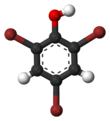2,4,6-Tribromophenol
| ||||
| Names | ||||
|---|---|---|---|---|
| IUPAC name
2,4,6-Tribromophenol
| ||||
| Other names
Tribromophenol; 2,4,6-TBP; TBP
| ||||
| Identifiers | ||||
3D model (JSmol)
|
||||
| ChEBI | ||||
| ChEMBL | ||||
| ChemSpider | ||||
| DrugBank | ||||
| ECHA InfoCard | 100.003.890 | |||
| KEGG | ||||
PubChem CID
|
||||
CompTox Dashboard (EPA)
|
||||
| ||||
| ||||
| Properties | ||||
| C6H3Br3O | ||||
| Molar mass | 330.801 g·mol−1 | |||
| Appearance | White needles or prisms[1] | |||
| Melting point | 95.5 °C (203.9 °F; 368.6 K)[1] | |||
| Boiling point | 244 °C (471 °F; 517 K)[3] 286 °C[1] | |||
| Slightly soluble[1] 59-61 mg/L[2] | ||||
| Hazards | ||||
| GHS labelling: | ||||
| class="wikitable collapsible" style="min-width: 50em;" | ||||
| Pictogram | Code | Symbol description | Image link | |
 |
GHS01 | {{GHS exploding bomb}} | Image:GHS-pictogram-explos.svg | Explosive |
 |
GHS02 | {{GHS flame}} | Image:GHS-pictogram-flamme.svg | |
 |
GHS03 | {{GHS flame over circle}} | Image:GHS-pictogram-rondflam.svg | |
 |
GHS04 | {{GHS gas cylinder}} | Image:GHS-pictogram-bottle.svg | |
 |
GHS05 | {{GHS corrosion}} | Image:GHS-pictogram-acid.svg | Corrosive |
 |
GHS06 | {{GHS skull and crossbones}} | Image:GHS-pictogram-skull.svg | Accute Toxic |
 |
GHS07 | {{GHS exclamation mark}} | Image:GHS-pictogram-exclam.svg | Irritant |
 |
GHS08 | {{GHS health hazard}} | Image:GHS-pictogram-silhouette.svg | Health Hazard |
 |
GHS09 | {{GHS environment}} | Image:GHS-pictogram-pollu.svg | Environment |
See also
- {{H-phrases}}
- {{P-phrases}}
- ‹The template Category link is being considered for merging.› Category:GHS templates
| Pictogram | Code | Symbol description | Image link | |
|---|---|---|---|---|
 |
GHS01 | {{GHS exploding bomb}} | Image:GHS-pictogram-explos.svg | Explosive |
 |
GHS02 | {{GHS flame}} | Image:GHS-pictogram-flamme.svg | |
 |
GHS03 | {{GHS flame over circle}} | Image:GHS-pictogram-rondflam.svg | |
 |
GHS04 | {{GHS gas cylinder}} | Image:GHS-pictogram-bottle.svg | |
 |
GHS05 | {{GHS corrosion}} | Image:GHS-pictogram-acid.svg | Corrosive |
 |
GHS06 | {{GHS skull and crossbones}} | Image:GHS-pictogram-skull.svg | Accute Toxic |
 |
GHS07 | {{GHS exclamation mark}} | Image:GHS-pictogram-exclam.svg | Irritant |
 |
GHS08 | {{GHS health hazard}} | Image:GHS-pictogram-silhouette.svg | Health Hazard |
 |
GHS09 | {{GHS environment}} | Image:GHS-pictogram-pollu.svg | Environment |
See also
- {{H-phrases}}
- {{P-phrases}}
- ‹The template Category link is being considered for merging.› Category:GHS templates[5]
|- | NFPA 704 (fire diamond)
|
|-
| colspan=2 style="text-align:left; background-color:#eaeaea;" | Lethal dose or concentration (LD, LC):
|-
|-
| style="padding-left:1em;" |
| 2000 mg/kg (rat, oral)[1]
|-
|-
| colspan=2 style="text-align:left; background:#f8eaba; border:1px solid #a2a9b1;" |
|-
|}
2,4,6-Tribromophenol (TBP) is a brominated derivative of phenol. It is used as a fungicide, as a wood preservative, and an intermediate in the preparation of flame retardants.
Production
Although natural TBP has been identified in ocean sediments as a metabolite of marine fauna,[6] the commercial product is prepared industrially. In 2001, the production volume of TBP was estimated to be 2500 tonnes/year in Japan and 9500 tonnes/year worldwide.[2] TBP can be prepared by the controlled reaction of elemental bromine with phenol:[3]
Uses
The predominant use of TBP is as an intermediate in the preparation of flame retardants such as brominated epoxy resins.[2] TBP is reacted with sodium hydroxide to form the sodium salt, which is used as a fungicide and wood preservative.
Bismuth salt
The bismuth salt is the active ingredient in Xeroform dressing.[7]
Metabolism
Microbial metabolism in products treated with TBP is known to produce 2,4,6-tribromoanisole (TBA),[8] which has a musty odor. In 2010 and 2011, Pfizer and Johnson & Johnson voluntarily recalled some products due to TBA odors from wooden pallets which were treated with TBP.[9][10][11][12]
References
- ^ a b c d e "3851: Tribromophenol" in Gardner's Commercially Important Chemicals: Synonyms, Trade Names, and Properties, G. W. A. Milne (Editor), ISBN 978-0-471-73518-2, page 632
- ^ a b c Concise International Chemical Assessment Document 66: 2,4,6-Tribromophenol and Other Simple Brominated Phenols, International Programme on Chemical Safety
- ^ a b Merck Index, 11th Edition, 9526
- ^ a b "Globally Harmonized System of Classification and Labelling of Chemicals" (pdf). 2021. Annex 3: Codification of Statements and Pictograms (pp 268–385).
- ^ Sigma-Aldrich Co., 2,4,6-Tribromophenol. Retrieved on 2015-02-19.
- ^ Fielman KT, Woodin SA, Lincoln DE (2001). "Polychaete indicator species as a source of natural halogenated organic compounds in marine sediments". Environmental Toxicology and Chemistry. 20 (4): 738–747. doi:10.1002/etc.5620200407. PMID 11345448.
- ^ https://www.nlm.nih.gov/cgi/mesh/2008/MB_cgi?field=uid&term=C004554
- ^ Frank B. Whitfield; Jodie L. Hill; Kevin J. Shaw (1997). "2,4,6-Tribromoanisole: a Potential Cause of Mustiness in Packaged Food". J. Agric. Food Chem. 45 (3): 889–893. doi:10.1021/jf960587u.
- ^ 38,000 more bottles of Lipitor recalled over odor complaints, CNN.com, October 30, 2010
- ^ Lipitor (atorvastatin) 40 mg: Recall Specific Bottles, drugs.com, Dec 23, 2010
- ^ Tylenol Recall Expands, WebMD Health News, January 18, 2010
- ^ McNeil Consumer Healthcare Announces Voluntary Recall Of One Product Lot Of TYLENOL® Extra Strength Caplets 225 Count Distributed In The U.S.




